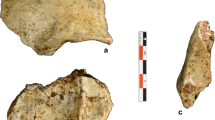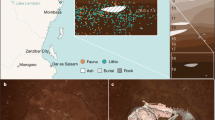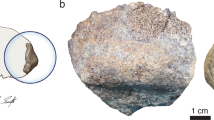Abstract
The timing and location of the emergence of our species and of associated behavioural changes are crucial for our understanding of human evolution. The earliest fossil attributed to a modern form of Homo sapiens comes from eastern Africa and is approximately 195 thousand years old1,2, therefore the emergence of modern human biology is commonly placed at around 200 thousand years ago3,4. The earliest Middle Stone Age assemblages come from eastern and southern Africa but date much earlier5,6,7. Here we report the ages, determined by thermoluminescence dating, of fire-heated flint artefacts obtained from new excavations at the Middle Stone Age site of Jebel Irhoud, Morocco, which are directly associated with newly discovered remains of H. sapiens8. A weighted average age places these Middle Stone Age artefacts and fossils at 315 ± 34 thousand years ago. Support is obtained through the recalculated uranium series with electron spin resonance date of 286 ± 32 thousand years ago for a tooth from the Irhoud 3 hominin mandible. These ages are also consistent with the faunal and microfaunal9 assemblages and almost double the previous age estimates for the lower part of the deposits10,11. The north African site of Jebel Irhoud contains one of the earliest directly dated Middle Stone Age assemblages, and its associated human remains are the oldest reported for H. sapiens. The emergence of our species and of the Middle Stone Age appear to be close in time, and these data suggest a larger scale, potentially pan-African, origin for both.
This is a preview of subscription content, access via your institution
Access options
Access Nature and 54 other Nature Portfolio journals
Get Nature+, our best-value online-access subscription
$29.99 / 30 days
cancel any time
Subscribe to this journal
Receive 51 print issues and online access
$199.00 per year
only $3.90 per issue
Buy this article
- Purchase on Springer Link
- Instant access to full article PDF
Prices may be subject to local taxes which are calculated during checkout



Similar content being viewed by others
References
McDougall, I., Brown, F. H. & Fleagle, J. G. Sapropels and the age of hominins Omo I and II, Kibish, Ethiopia. J. Hum. Evol. 55, 409–420 (2008)
Brown, F. H., McDougall, I. & Fleagle, J. G. Correlation of the KHS Tuff of the Kibish Formation to volcanic ash layers at other sites, and the age of early Homo sapiens (Omo I and Omo II). J. Hum. Evol. 63, 577–585 (2012)
Scheinfeldt, L. B., Soi, S. & Tishkoff, S. A. Colloquium paper: working toward a synthesis of archaeological, linguistic, and genetic data for inferring African population history. Proc. Natl Acad. Sci. USA 107, 8931–8938 (2010)
Gronau, I., Hubisz, M. J., Gulko, B., Danko, C. G. & Siepel, A. Bayesian inference of ancient human demography from individual genome sequences. Nat. Genet. 43, 1031–1034 (2011)
Deino, A. L. & McBrearty, S. 40Ar/39Ar dating of the Kapthurin Formation, Baringo, Kenya. J. Hum. Evol. 42, 185–210 (2002)
Sahle, Y., Morgan, L. E., Braun, D. R., Atnafu, B. & Hutchings, W. K. Chronological and behavioral contexts of the earliest Middle Stone Age in the Gademotta Formation, Main Ethiopian Rift. Quat. Int. 331, 6–19 (2014)
Porat, N. et al. New radiometric ages for the Fauresmith industry from Kathu Pan, southern Africa: implications for the Earlier to Middle Stone Age transition. J. Archaeol. Sci. 37, 269–283 (2010)
Hublin, J.-J. et al. New fossils from Jebel Irhoud, Morocco and the pan-African origin of Homo sapiens. Nature http://dx.doi.org/10.1038/nature22336 (2017)
Geraads, D. et al. The rodents from the late Middle Pleistocene hominid-bearing site of J’bel Irhoud, Morocco, and their chronological and paleoenvironmental implications. Quat. Res. 80, 552–561 (2013)
Smith, T. M. et al. Earliest evidence of modern human life history in north African early Homo sapiens. Proc. Natl Acad. Sci. USA 104, 6128–6133 (2007)
Grün, R. & Stringer, C. B. Electron spin resonance dating and the evolution of modern humans. Archaeometry 33, 153–199 (1991)
Hublin, J.-J., Tillier, A. M. & Tixier, J. L’humérus d’enfant moustérien (Homo 4) du Djebel Irhoud (Maroc) dans son contexte archéologique. Bull. Mem. Soc. Anthropol. Paris 4, 115–141 (1987)
Hublin, J.-J. Recent human evolution in northwestern Africa. Phil. Trans. R. Soc. Lond. B 337, 185–191 (1992)
Grün, R., Schwarcz, H. P. & Chadam, J. ESR dating of tooth enamel: Coupled correction for U-uptake and U-series disequilibrium. Int. J. Rad. Appl. Instrum. D 14, 237–241 (1988)
Tixier, J ., Brugal, J ., Tillier, A. M ., Bruzek, J . & Hublin, J. Irhoud 5, un fragment d’os coxal non-adulte des niveaux moustériens marocains. Actes J. Natl. Archéol. Patrim. Maroc 149–153 (2001)
Lisiecki, L. E. & Raymo, M. E. A Pliocene–Pleistocene stack of 57 globally distributed benthic δ18O records. Paleoceanography 20, PA1003 (2005)
Richter, D., Dombrowski, H., Neumaier, S., Guibert, P. & Zink, A. C. Environmental gamma dosimetry with OSL of α-Al2O3:C for in situ sediment measurements. Radiat. Prot. Dosimetry 141, 27–35 (2010)
Richter, D. & Krbetschek, M. Luminescence dating of the Lower Palaeolithic occupation at Schöningen. J. Hum. Evol. 89, 46–56 (2015)
Schwarcz, H. P. Current challenges to ESR dating. Quat. Sci. Rev. 13, 601–605 (1994)
Mercier, N., Valladas, H. & Valladas, G. Observations on palaeodose determination with burnt flints. Anc. TL 10, 28–32 (1992)
Mercier, N. Flint palaeodose determination at the onset of saturation. Int. J. Rad. Appl. Instrum. D 18, 77–79 (1991)
Valladas, G. & Gillot, P. Y. Dating of the Olby lava flow using heated quartz pebbles: some problems. PACT 2, 141–150 (1978)
Richter, D. Advantages and limitations of thermoluminescence dating of heated flint from Paleolithic sites. Geoarchaeology 22, 671–683 (2007)
Joannes-Boyau, R. & Grün, R. A comprehensive model for CO2- radicals in fossil tooth enamel: implications for ESR dating. Quat. Geochronol. 6, 82–97 (2011)
Grün, R. An alternative model for open system U-series/ESR age calculations: (closed system U-series)-ESR, CSUS-ESR. Anc. TL 18, 1–4 (2000)
Grün, R. et al. Direct dating of Florisbad hominid. Nature 382, 500–501 (1996)
Ramos, J. et al. The Benzú rockshelter: a Middle Palaeolithic site on the north African coast. Quat. Sci. Rev. 27, 2210–2218 (2008)
Adler, D. S. et al. Early Levallois technology and the Lower to Middle Paleolithic transition in the southern Caucasus. Science 345, 1609–1613 (2014)
Larrasoaña, J. in Modern Origins: A North African Perspective (eds Hublin, J.-J. & McPherron, S. P. ) 19–34 (Springer, 2012)
Geraads, D. Biogeographic relationships of Pliocene and Pleistocene north-western African mammals. Quat. Int. 212, 159–168 (2010)
Prescott, J. R. & Hutton, J. T. Cosmic ray contributions to dose rates for luminescence and ESR dating: large depths and long-term time variations. Radiat. Meas. 23, 497–500 (1994)
Aitken, M. J. Thermoluminescence Dating (Academic, 1985)
Mercier, N. & Valladas, H. Reassessment of TL age estimates of burnt flints from the Paleolithic site of Tabun Cave, Israel. J. Hum. Evol. 45, 401–409 (2003)
Valladas, H. et al. Thermoluminescence dates for the Neanderthal burial site at Kebara in Israel. Nature 330, 159–160 (1987)
Valladas, H. et al. Thermoluminescence dating of mousterian ‘Troto-Cro-Magnon’ remains from Israel and the origin of modern man. Nature 331, 614–616 (1988)
Rink, W. J., Schwarcz, H. P., Ronen, A. & Tsatskin, A. Confirmation of a near 400 ka age for the Yabrudian industry at Tabun Cave, Israel. J. Archaeol. Sci. 31, 15–20 (2004)
Mercier, N. et al. New datings of Amudian layers at Qesem Cave (Israel): results of TL applied to burnt flints and ESR/U-series to teeth. J. Archaeol. Sci. 40, 3011–3020 (2013)
Frouin, M. et al. Chronology of the Middle Palaeolithic open-air site of Combe Brune 2 (Dordogne, France): a multi luminescence dating approach. J. Archaeol. Sci. 52, 524–534 (2014)
Prescott, J. R., Huntley, D. J. & Hutton, J. T. Estimation of equivalent dose in thermoluminescence dating — the Australian slide method. Anc. TL 11, 1–5 (1993)
Sanzelle, S., Miallier, D., Pilleyre, T., Faïn, J. & Montret, M. A new slide technique for regressing TL/ESR dose response curves—intercomparison with other techniques. Radiat. Meas. 26, 631–638 (1996)
Guibert, P., Vartanian, E., Bechtel, F. & Schvoerer, M. Non linear approach of TL response to dose: polynomial approximation. Anc. TL 14, 7–14 (1996)
Berger, G. W. Thermoluminescence dating studies of rapidly deposited silts from south-central British Columbia. Can. J. Earth Sci. 22, 704–710 (1985)
Valladas, H. & Valladas, G. Effect de l’irradiation alpha sur des grain de quartz. PACT 6, 171–179 (1982)
Adamiec, G. & Aitken, M. Dose-rate conversion factors: update. Anc. TL 16, 37–50 (1998)
Guibert, P., Lahaye, C. & Bechtel, F. The importance of U-series disequilibrium of sediments in luminescence dating: a case study at the Roc de Marsal Cave (Dordogne, France). Radiat. Meas. 44, 223–231 (2009)
Tribolo, C. et al. TL dating of burnt lithics from Blombos Cave (South Africa): further evidence for the antiquity of modern human behaviour. Archaeometry 48, 341–357 (2006)
Schmidt, C., Rufer, D., Preusser, F., Krbetschek, M. & Hilgers, A. The assessment of radionuclide distribution in silex by autoradiography in the context of dose rate determination for thermoluminescence dating. Archaeometry 55, 407–422 (2013)
Ennouchi, E. Essai de datation du gisement de Jebel Irhoud (Maroc). Comptes Rendus Somm. Séances Société. Geol. Fr. 10, 405–406 (1966)
Arambourg, C. Le gisement moustérien et l’homme du Jebel Irhoud. Quaternaria 7, 1–7 (1965)
Ennouchi, E. Le site du Jebel Irhoud (Maroc). in Actas del V Congreso Panafricano de Prehistoria y de Estudio del Cuaternario (Santa Cruz de Tenerife, 1963) 6, 53–60 (1966)
Guibert, P., Bechtel, F., Schvoerer, M., Müller, P. & Balescu, S. A new method for gamma dose-rate estimation of heterogenous media in TL dating. Radiat. Meas. 29, 561–572 (1998)
Guérin, G. Modélisation et Simulations Numérique des Effets Dosimétriques dans les Sediments Quaternaires: Application aux Méthodes de Datation par Luminescence. PhD thesis, Univ. Bordeaux (2012)
Guérin, G. & Mercier, N. Field gamma spectrometry, Monte Carlo simulations and potential of non-invasive measurements. Geochronometria 39, 40–47 (2012)
Mercier, N., Valladas, H., Valladas, G. & Reyss, J.-L. TL dates of burnt flints from Jelinek’s excavations at Tabun and their implications. J. Archaeol. Sci. 22, 495–509 (1995)
Falguères, C. et al. Combined ESR/U-series chronology of Acheulian hominid-bearing layers at Trinchera Galería site, Atapuerca, Spain. J. Hum. Evol. 65, 168–184 (2013)
Michel, V., Delanghe-Sabatier, D., Bard, E. & Ruiz, C. B. U-series, ESR and 14C studies of the fossil remains from the Mousterian levels of Zafarraya Cave (Spain): a revised chronology of Neandertal presence. Quat. Geochronol. 15, 20–33 (2013)
Wagner, G. A. et al. Radiometric dating of the type-site for Homo heidelbergensis at Mauer, Germany. Proc. Natl Acad. Sci. USA 107, 19726–19730 (2010)
Eggins, S., Grün, R., Pike, A. W. G., Shelley, M. & Taylor, L. 238U, 232Th profiling and U-series isotope analysis of fossil teeth by laser ablation-ICPMS. Quat. Sci. Rev. 22, 1373–1382 (2003)
Grün, R., Aubert, M., Joannes-Boyau, R. & Moncel, M.-H. High resolution analysis of uranium and thorium concentration as well as U-series isotope distributions in a Neanderthal tooth from Payre (Ardèche, France) using laser ablation ICP-MS. Geochim. Cosmochim. Acta 72, 5278–5290 (2008)
Grün, R., Eggins, S., Kinsley, L., Moseley, H. & Sambridge, M. Laser ablation U-series analysis of fossil bones and teeth. Palaeogeogr. Palaeoclimatol. Palaeoecol. 416, 150–167 (2014)
Ennouchi, E. Le deuxième crane de l’homme d’Irhoud. Ann. Paleontol. LIV, 117–128 (1968)
Nathan, R. & Grün, R. Gamma dosing and shielding of a human tooth by a mandible and skull cap: Monte Carlo simulations and implications for the accuracy of ESR dating of tooth enamel. Anc. TL 21, 79–84 (2003)
Grün, R. & Katzenberger-Apel, O. An alpha irradiator for ESR dating. Anc. TL 12, 35–38 (1994)
Grün, R. Alpha dose attenuation in thin layers. Anc. TL 5, 6–8 (1987)
Valladas, H. Datation par la Thermoluminescence de Gisements Moustériens du Sud de la France PhD Thesis, Univ. Paris VI (1985)
Acknowledgements
The Jebel Irhoud project is jointly conducted and supported by the Moroccan Institut National des Sciences de l’Archéologie et du Patrimoine and the Department of Human Evolution of the Max Planck Institute for Evolutionary Anthropology (MPI-EVA). We thank S. Albert (MPI-EVA) for sample preparation and for measuring the flint samples, E. Pernicka (Curt-Engelhorn-Zentrum Archäometrie, Mannheim) for neutron activation analysis and D. Degering (Verein für Kernverfahrenstechnik und Analytik, Rossendorf) for performing γ-ray spectrometry. The Max Planck Society funded the fieldwork and the thermoluminescence analysis. V. Aldeias (MPI-EVA) excavated the partial skull. B. Larmignat illustrated the stone artefacts. Philipp Gunz commented on the manuscript, and Les Kinsley (RSES, ANU) assisted with laser ablation measurements. Parts of the US/ESR research were funded by ARC discovery grants (DP0664144 to R.G.) and (DP140100919 to R.J.-B.)
Author information
Authors and Affiliations
Contributions
Thermoluminescence dating was carried out by D.R.; ESR dating was done by R.G. and R.J.-B.; zooarchaeology and taphonomy was carried out by F.A., T.E.S. and D.G.; lithics analysis was done by S.P.M.; raw material analysis was carried out by P.F. and J.P.R.; geology was done by J.-P.R., P.F. and M.R.; and A.B.-N., J.-J.H. and S.P.M. excavated the site. D.R. and S.P.M. wrote the paper with contributions from all authors.
Corresponding author
Ethics declarations
Competing interests
The authors declare no competing financial interests.
Additional information
Reviewer Information Nature thanks R. G. Klein, R. G. Roberts and the other anonymous reviewer(s) for their contribution to the peer review of this work.
Publisher's note: Springer Nature remains neutral with regard to jurisdictional claims in published maps and institutional affiliations.
Extended data figures and tables
Extended Data Figure 1 View south of the remaining sediments at the start of excavations in 2004.
The approximate area of the main fossil concentration (not actually visible in this initial photograph taken before our excavations) is circled in red and detailed in Fig. 1b, c. The stacked rocks around the base of the sediments and ramping up to the sediments on the left were placed there for protection of the remaining deposits. The white tags mark dosimeter locations. The scale is correct for the section with the tags.
Extended Data Figure 2 Non-polarized light photomicrographs from thin-sections.
a, Layer 4, thin-section 608M, showing the good preservation of the sediment owing to overlying cave lithoclasts. b, Layer 4, thin-section 608M, clasts are oriented with unit dip. c, Layer 7 upper part, thin-section 712T, indicating a run-off deposit. d, Layer 7, thin-section 609T, bone micro-fragments in an isotropic fabric microfacies. e, Lower part of layer 7, thin-section 716, with a high density of micro-charcoal, soil aggregates, bone fragments and heated lithoclasts. f, Trampled surface in layer 7, thin-section 712B (thin sections by M. El Graoui). Photos by M.R.
Extended Data Figure 3 Cross-polarized and plane-polarized photomicrographs from thin-section of micromorphology sample 717 (layer 7).
a, Scanned thin section. Squares with letters in a refer to the areas in b–e, each area provided as plane- (PPL) and cross-polarized (XPL) images. Scale bar, 0.5 mm. Bio indicates bioturbation and the numbers refer to the sub-units as indicated by dotted lines. ST refers to structure. b, Black coatings against a biogallery wall. c, Micro-bedded carbon products preserved under a schisteous clast. d, Carbon aggregates that coat the bottom of ST1. e, bed of carbon micro-particles in the filling of ST1. Photos by M.R.
Extended Data Figure 4 Flint artefacts.
a, b, e, Unifacial points (layer 6). c, d, Convergent scrapers (layer 6). f, Déjeté scraper (layer 6). g, h, Convergent scrapers (layer 7). i, Unifacial point (layer 7). j, Levallois Flake (layer 7). k, m, Double scrapers (layer 7). l, Déjeté scraper (layer 7). n, Single scraper (layer 7).
Extended Data Figure 5 Stone artefacts from layer 7.
a, b, Quartz flakes. c, m, Flint Levallois flakes. d, i, Silicified limestone flakes. e, g, h, Flint flakes with some edge damage. f, Flint flake. j, n, Silicified limestone flakes with some edge damage. k, l, Flint Levallois flakes with some edge damage.
Extended Data Figure 6 Stone artefacts from layer 7.
a, c, Single scrapers. b, Double scraper with some edge damage. d, Notch on silicified limestone. e, Single scraper with some edge damage on a Levallois flake. f, Convergent denticulate (Tayac Point). g, Double scraper. h, Déjeté scraper. i, Unifacial point. All artefacts are flint unless noted otherwise.
Extended Data Figure 7 Dose–response curves of the exponentially fitted thermoluminescence temperature integrals, where the regeneration dose–response curves were shifted along the dose axis to obtain the palaeodoses.
The similarity (homothety) of the dose–response curves is given by the ratios of the thermoluminescence integrals of the additive and shifted regeneration dose–response curves at the additive dose points. The inset depicts the glow curves and the heating plateau for 300–600 Gy additive β-irradiations.
Supplementary information
Supplementary Information
This file contains Supplementary Text, Supplementary Tables 1-2 and Supplementary References. (PDF 402 kb)
Rights and permissions
About this article
Cite this article
Richter, D., Grün, R., Joannes-Boyau, R. et al. The age of the hominin fossils from Jebel Irhoud, Morocco, and the origins of the Middle Stone Age. Nature 546, 293–296 (2017). https://doi.org/10.1038/nature22335
Received:
Accepted:
Published:
Issue Date:
DOI: https://doi.org/10.1038/nature22335
This article is cited by
-
A Late Pleistocene hominin footprint site on the North African coast of Morocco
Scientific Reports (2024)
-
Jbel Irhoud Geosite, the Cradle of Humanity (Youssoufia Province, Marrakech-Safi region, Morocco): Evaluation and Valorization of the Geological Heritage for Geoeducation and Geotourism Purposes
Geoheritage (2024)
-
Longstanding behavioural stability in West Africa extends to the Middle Pleistocene at Bargny, coastal Senegal
Nature Ecology & Evolution (2023)
-
Identifying signatures of positive selection in human populations from North Africa
Scientific Reports (2023)
-
A weakly structured stem for human origins in Africa
Nature (2023)
Comments
By submitting a comment you agree to abide by our Terms and Community Guidelines. If you find something abusive or that does not comply with our terms or guidelines please flag it as inappropriate.



